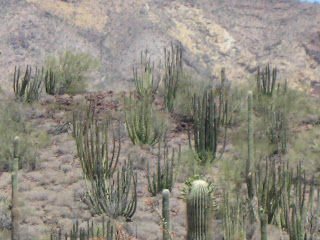One is more than prepared for the desolation and danger of Organ Pipe Cactus National Monument, even before once reaches the one-horse town of Why, AZ, or the site's visitor center, named for park ranger Kris Eggle, slain in 2002 while pursuing members of a drug cartel. Highway 86, the only route to the monument from Tucson, is lonely in that way unique to the Southwest, but more than that, it's a virtual graveyard of woe. Along this stretch, drivers will see more descansos - Spanish for "place of rest" - than any other spot in the country. It is no exaggeration to say that these roadside memorials, usually consisting of crosses, flowers, candles, and small religious statues, number in the dozens, some so unusually large that they are difficult to distinguish from an actual burial site. Is travel along this road exceedingly dangerous for any discernible reason? It's not particularly windy, or uneven, or chock full of hairpins, so one must logically conclude that its remoteness, combined with a healthy intake of alcohol, leads to the appallingly high death toll. Somehow, in a manner no less twisted, this is appropriate for the task at hand, as the journey to and through Organ Pipe is not for the timid, ensuring a more suitable reward at trip's end.
The monument itself, so close to the U.S./Mexican border than one can view it well before one reaches the last outpost of Lukeville, is among the most dangerous in the NPS system, hence the heavy presence of border patrol agents and all manner of law enforcement. That said, once one crawls through the checkpoint, they remain all but invisible to the casual traveler, ensuring a trip much superior to the more "city friendly" Saguaro National Park. There, Tucson's protective grip is always present (more so in the Rincon Mountain District), making it a little difficult to surrender to the desert's allure. Organ Pipe presents no such problems, and, if anything, one's most frequent gesture will be to keep checking the gas tank to ensure that one will get out unscathed. Don't assume you can make it back to Ajo for provisions.
Once you drive the few miles down to Lukeville for a quick glance at the border (we left our passports at home this time, so no crossing for us), make your way back to the VC for a choice: the 10-mile North Puerto Blanco Drive, or the 21-mile Ajo Mountain Drive. The former was originally a 53-mile loop, but the standard border "issues" closed all but ten to the viewing public. We chose the Ajo option, if only because, at a greater length, we wanted the full treatment. Because this route is unpaved, allow for 90 slow-going minutes up and along the Ajo Range.
Do not make the same mistake we did at first, assuming that the absence of Organ Pipe cacti would dominate the loop drive. We knew they were relatively rare in the United States, but this elusive? Be patient, for as you get closer to the Ajo Range, the site's namesake bursts forth with the expected flourish. Perhaps they lack the singular majesty of the Saguaro, but the Organ Pipe possess a charm all their own. Again, this monument exceeds Saguaro National Park in one chief respect: here, you get both in all their glory, and I'll be damned if there's a cyclist or fellow human to be found. We didn't spot a single car on our drive, and the silence was so blissfully intoxicating that we couldn't help but gulp it all in. There are frequent stops (thanks to the handy - and educational - drive guide called Desert Adaptations), but you can see everything from the car just fine. Hiking might be nice for some, but here, it honestly isn't necessary. And no, we're not just being lazy. The road cuts right through the action, leaving all visitors, even the car-bound, with all they need.
Among the highlights enhanced by the guide include: the prickly pear, jojoba (a waist-high, blue-green shrub), mesquite trees, and the teddy bear cholla. Still, nothing sent our minds reeling more than the chain-fruit cholla, a pale yellow, tree-shaped cacti that feature hanging fruit that forms a long chain. The kicker is best described by the guide itself: "The joints of the plant are biologically designed to detach as an animal is walking by within its spiny reach....The spines are barbed and hook into the coat or flesh of the passer-by and the cholla plant is transported to a new location." To fail to be impressed by the intricacies of evolution after that little piece speaks to a mind that will, alas, never open. But it's all around you - Darwin's theories in full view, unlocking the awesomeness of nature for all to see. It's why we travel so many miles to places few people, let alone water and a hospitable climate, ever see. There are no comforting fables here, only harsh realities. Survival at all costs. The desert on its own terms.
FINAL RATING
9.5/10











Going there next October since I'll be in AZ for a wedding in PHX. Thanx for the great review.
ReplyDelete